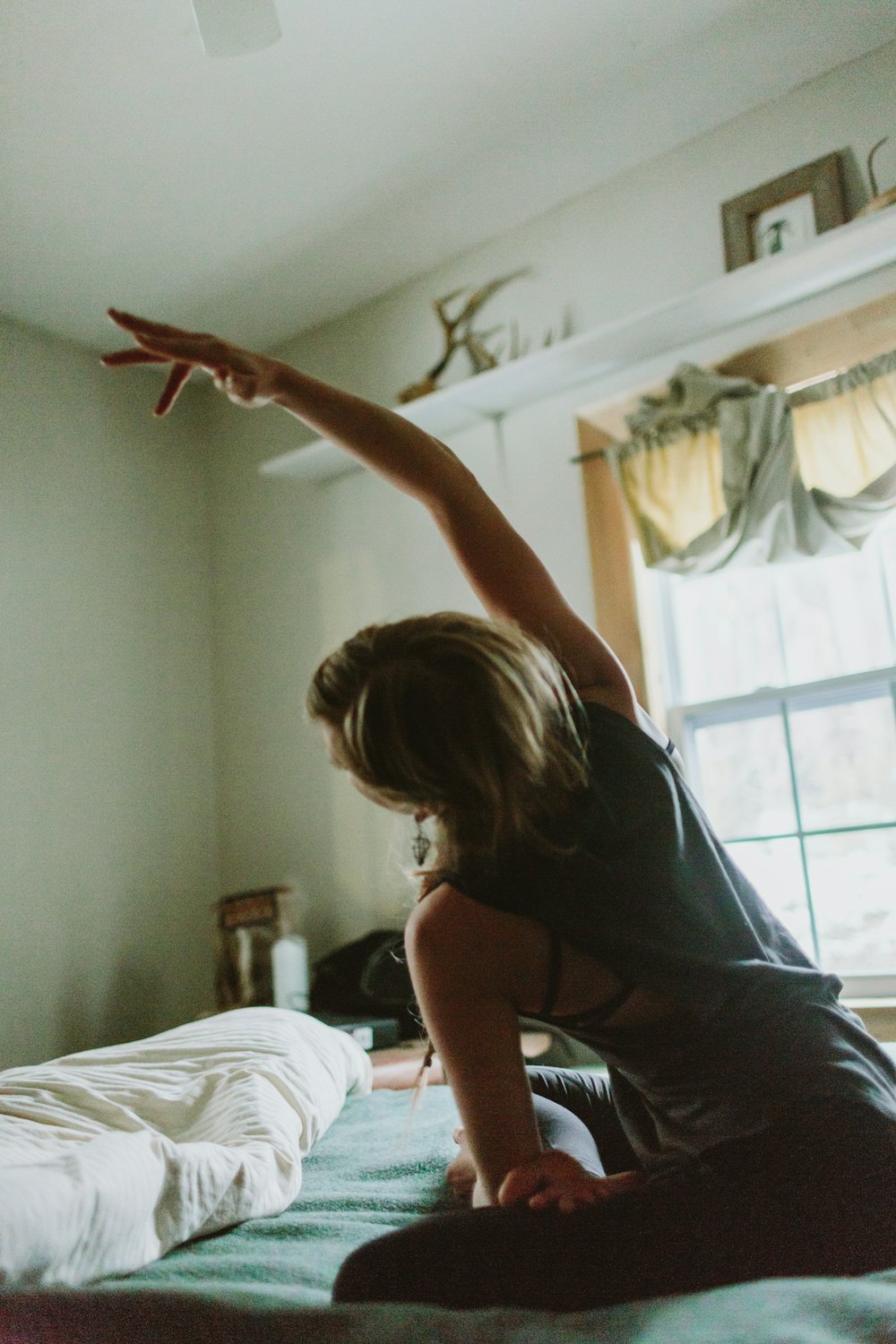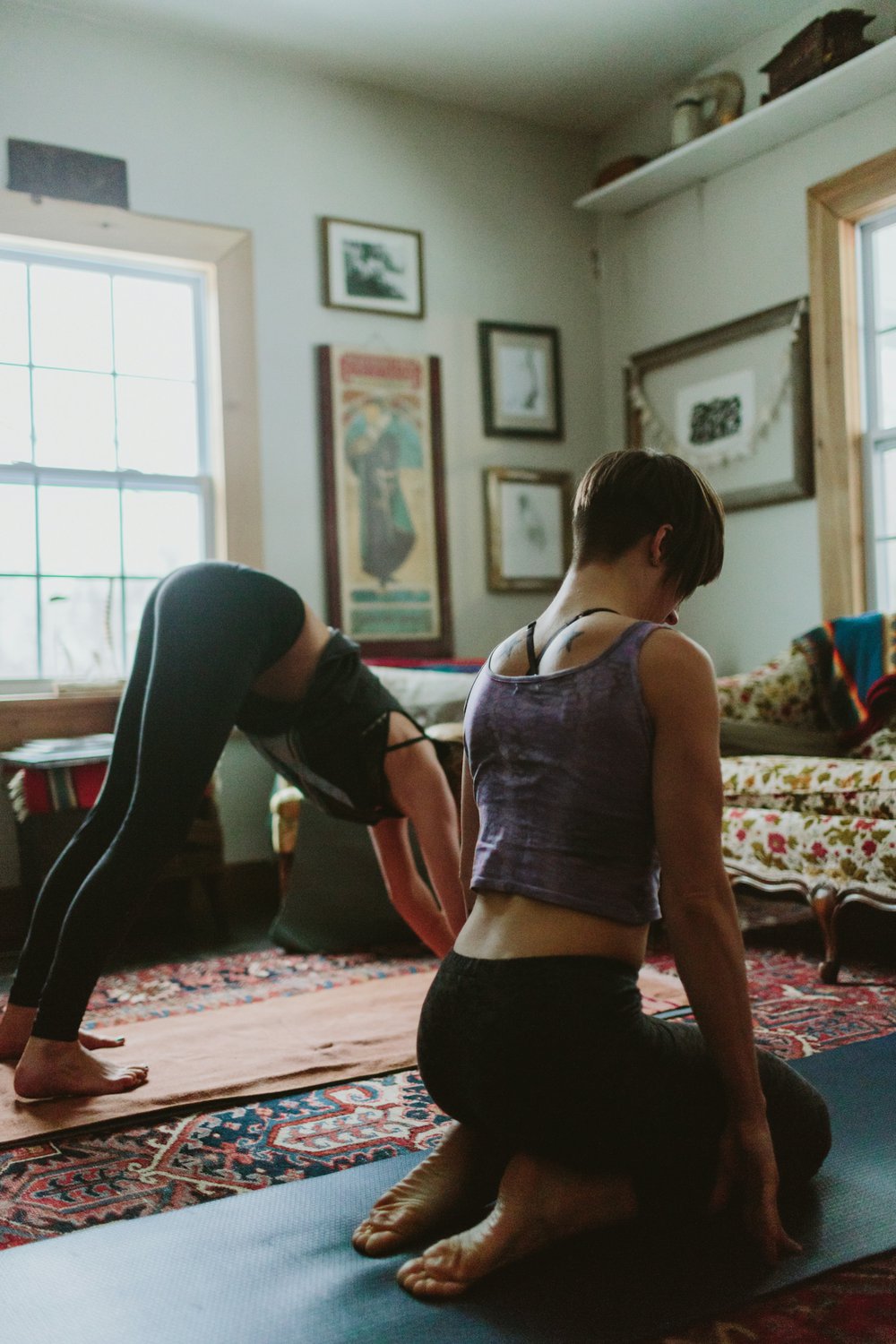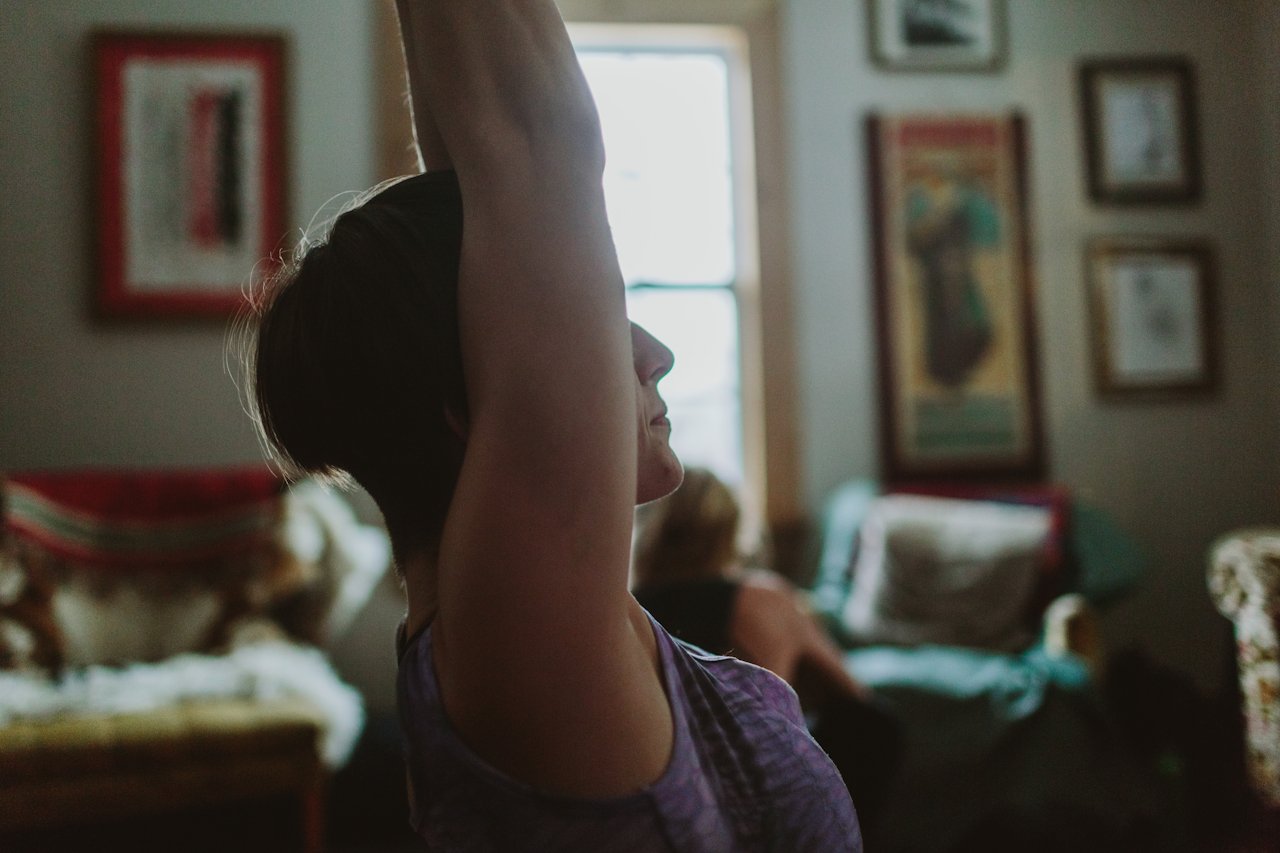March 15, 2024
Crafting Your Personal Yoga Ritual: A Guide to Consistent At-Home Practice with Online Yoga
Explore our guide to establishing a consistent, enjoyable yoga habit with your subscription.
Did you recently subscribe to an online yoga class but are finding it challenging to stay motivated and establish a yoga habit? You're not alone! Many of us, in a burst of excitement, commit to a new wellness or workout regime, only to later realize that choosing the studio is the easy part; the real challenge lies in showing up consistently.
This blog explains how to establish your own personal yoga ritual at home. This will not only increase your likelihood of using your mat, but also make it a process you enjoy.
We build little rituals into various areas of our life, from our morning coffee routines, to how we choose to relax, and of course how we approach our yoga mat and workouts. These non-spiritual rituals play a crucial role in our daily lives, giving structure to our days, and helping us move from not only one physical space to another, but also mentally switch gears.
If you are looking a new way to build your daily yoga habit, then building your own personal ritual may be the answer. It is perfect for those that are not interested in check marks or trackers, but rather building a meaningful practice they love and want to continue for not just days, but years.
Setting up your at-home yoga practice can significantly transform your experience and help you develop a wellness habit that you enjoy. Similar to how an in-person yoga studio invests time and effort into creating a warm, tidy, and inviting space, possibly even using diffusers or candles to engage all senses, your home yoga space can also impact your feelings.
In an article about the impact of our homes on us, the researchers argue that physical spaces in our home can be a “particularly pervasive and powerful mechanism for regulating emotion,” which likely isn’t a shock to most of us.

The Foundation of Your At-Home Yoga Habit
So how can you take advantage of your space and create a ritual that helps build your at home yoga practice?
You start with building a foundation. This of this as an opportunity to take account of what resources you already have, and what small adjustments you can make at home to begin your yoga ritual.
The first step involves considering the physical space. Don't hesitate to try placing your mat in various locations to see what works best. The ideal spot for your yoga practice might surprise you. Take into account factors such as light, comfort, and potential distractions. Use this as an opportunity to declutter and rearrange your space to create the atmosphere you desire for your practice. You might consider adding elements like a diffuser, candles, or plants from other rooms.
After trying out different areas, decluttering, and setting up your space, it's time to experiment with the atmosphere. This could involve adjusting the lighting, such as natural light or candles, or using aromatherapy.
At this time, consider creating a pre-practice ritual. This could involve setting an intention, lighting a candle, or engaging in a brief meditation to foster a practice mindset.
What is important when layering on these three aspect of your ritual foundation is the willingness to try new things. If you don’t love bright natural light, then perhaps your bedroom with the blinds closed it better than the living room.
Exploring Your Personal Yoga Practice
Once you've found a spot you like, adjusted your atmosphere, and added a pre-practice action, it's time to explore what type of practice will keep you engaged.
At Heart + Bones Yoga, we offer hundreds of classes, ranging from deeply restorative sessions to quick, energizing workouts. We encourage you to spend at least a week exploring different styles to discover what resonates with you. While your needs from your yoga practice may vary from day to day, it's important not to pre-judge certain styles.
Treat this time as an opportunity to explore and experiment. In fact, you're allowed to leave a class if you don't enjoy it and choose something else. Once you start understanding which style suits you, you'll feel more confident in selecting a class and practicing according to your needs. Remember, you're aiming to establish a yoga habit, which requires time , consistency, which will not happen if you don’t enjoy yourself.
As you practice take time to explore using props, and stay open to adjusting postures to your personal needs. If you need to adjust for knee pain, or focus on classes that are seated, Heart + Bones has plenty for you to try. And once you begin to learn your needs it will become easier to modify almost any class.
Another crucial factor to consider is the time of day for practicing yoga at home. If mornings are rushed with work, and finding alone time is challenging, consider practicing yoga before bedtime. Alternatively, adjust your schedule on a weekly basis. The perfect time is the one you can consistently maintain. Some people find it beneficial to start or end their day with yoga, while others may prefer a quick movement break at lunch.
Enhance Your At Home Yoga Practice
Now that you have the foundation of space, ambiance, and yoga style established, you may want to explore more subtle but impactful ways to build your yoga habit and ritual. If you love music, you may want to create a playlist to play while you move. It may also help you mentally prepare for practice. Test out a more silent practice, then try with music.
Consider incorporating a stacked or built-out style of practice. For instance, you could start with a short meditation under 10 minutes, followed by a 15-minute class, and end with a 5-minute savasana. You have full control over your home yoga practice. Don't feel obligated to take long classes if they don't fit your schedule, and feel free to stack classes to create an enjoyable experience.
Enhancing your practice can also involve engaging your senses. We've previously discussed using aromatherapy and music. However, don't overlook sight, touch, and taste! Consider using a comfortable yoga mat and donning clothes that feel pleasant against your skin. You might also enjoy a cup of tea or your favourite smoothie before or after your practice. Additionally, consider taking a moment to self-massage sore muscles with essential oils.

Establish Consistency in Your Yoga Practice
Now that you've explored different times of the day to practice, it's time to commit. Try practicing at the same time every day for a week to build a yoga habit. If you're a beginner or returning to a yoga practice, it's best to start small and gradually increase your practice time. For instance, aim for 10-15 minutes Monday through Friday or try two longer classes a week based on your schedule. Health guidelines recommend 150 minutes of moderate to vigorous activity per week, and yoga can be a part of that. Starting with shorter but more frequent sessions is generally more manageable as it doesn't require a significant time commitment. Plus, it's easier to find a little time in the day. This approach also reduces the likelihood of becoming sore and not wanting to practice the next day. The goal is consistency, not intensity.
If you haven't yet shared your new yoga habit with your household or your friends, now is the time to do so! You might find that someone wants to join you. Having someone ask about your progress can naturally motivate you to continue practicing.
If you're prepared to establish your personal yoga habit and ritual, consider trying the Heart + Bones trial membership. It's an excellent opportunity to explore various styles and customize a practice that feels right for you.
Below is a simple 4-week checklist to help you explore and build your personal yoga habit.
Week 1: Setting the Foundation
Focus: Space and Atmosphere
- Task 1: Begin by selecting three different spots in your home to practice yoga, considering factors like natural light, comfort, and potential distractions. Practice in each space at least once to see which setting feels most conducive to your practice.
- Task 2: Before each session, take a moment to adjust the atmosphere of your chosen spot. Experiment with dimming the lights, lighting a candle, or incorporating an essential oil diffuser to enhance the sensory experience of your practice.
- Task 3: Establish a pre-practice ritual to transition into your yoga mindset. This could involve setting a specific intention for your practice, engaging in a brief meditation, or simply lighting a candle. Try a different ritual in each of the three sessions and note which one resonates with you the most.
Reflection: At the end of the week, reflect on how each physical space and atmospheric adjustment influenced your yoga practice. Consider the comfort, distractions, and overall ambiance. Which setup helped you feel most focused and at ease? How did the pre-practice rituals affect your readiness and mindset for yoga? Write down your thoughts and decide on the best combination of space, atmosphere, and ritual to carry forward into the next week.
Week 2: Exploring Your Personal Yoga Practice
Focus: Practice Structure and Styles
- Task 1: Dedicate this week to trying a variety of online yoga classes offered by your yoga subscription. Aim to practice a different style each time, ranging from deeply restorative sessions to energizing flows. Note how each style makes you feel and which ones seem to suit your current needs best.
- Task 2: Experiment with using props in your practice. This could mean using books as blocks, a belt as a strap, or cushions for support. Pay attention to how modifications and props can enhance your comfort and enable you to engage more deeply with each pose.
- Task 3: Play with the timing of your practice. Try yoga at different times of the day—morning, midday, and evening—to discover when you feel most receptive and energized by your practice. Consider your daily schedule and how yoga can best fit into it as a consistent routine.
Reflection: After exploring various yoga styles, using props, and experimenting with practice times, reflect on your experiences. Which styles resonated with you the most, and why? How did the use of props affect your practice? Did you find a time of day that seems ideal for your yoga sessions? Write down your insights and preferences, as these will guide you in tailoring your ongoing yoga practice to your personal needs and lifestyle.
Week 3: Enhancing Your At-Home Yoga Practice
Focus: Exploration of Sound and Practice Structure
- Task 1: Investigate the role of sound in your yoga practice. Since most classes do not come with playlists, start one session in its natural state without additional music to fully experience the class as is, focusing on the instructor's guidance and your breath. For your next practice, select your favorite calming and meditative music to play in the background. If you have another opportunity, try a session with energizing music. Notice how each auditory environment impacts your focus, mood, and overall engagement with the practice.
- Task 2: Structure your yoga practice in a "stacked" format to explore different components of a comprehensive session. Begin with a short meditation (under 10 minutes), followed by a primary yoga class tailored to your preference (aiming for 15-30 minutes), and conclude with a 5-minute savasana or relaxation period. Adjust the duration of each part as needed to fit your schedule and preferences.
- Task 3: Enhance your practice through sensory engagement, focusing on the sense of touch and taste. Ensure your yoga mat and outfit provide comfort and ease, and consider incorporating a sensory ritual like enjoying a favourite tea or smoothie before or after your yoga session. Additionally, self-massage with essential oils could be a soothing conclusion to your practice.
Reflection: Reflect on how the exploration of sound influenced your yoga sessions. How did practicing with no music compare to sessions accompanied by your chosen playlists? Did the "stacked" structure of your practice enhance your experience, and in what ways? Were there any sensory practices (like enjoying a beverage or using essential oils) that particularly enriched your post-yoga feeling? Compile your observations to guide how you might integrate these elements into your ongoing practice for a richer, more personalized yoga experience.
Week 4: Establishing Consistency in Your Yoga Practice
Focus: Routine and Habit Building
- Task 1: Choose a consistent time each day for your yoga practice, aiming for the same time slot every day this week. This helps in establishing a routine your body and mind can get accustomed to. If mornings are your chosen time, consider a gentle wake-up session. If evenings, perhaps a practice to wind down.
- Task 2: Start with manageable practice durations that fit easily into your daily life. If you're new or returning to yoga, aim for 10-15 minutes of practice Monday through Friday. For a bit more challenge, opt for longer sessions throughout the week. The key is to build a habit that feels sustainable and enjoyable.
- Task 3: Share your intention to build a consistent yoga practice with friends or family members. Invite them to join you in a session or simply share your experiences and progress with them. External accountability can be a powerful motivator in keeping you consistent with your practice.
Reflection: At the end of the week, take time to reflect on the impact of integrating yoga into your daily routine. How has practicing at the same time each day affected your consistency and overall wellbeing? Did you find the chosen duration manageable and beneficial? How did sharing your yoga journey with others influence your motivation and commitment? Use these insights to adjust and refine your practice moving forward, ensuring that yoga remains a rewarding and consistent part of your lifestyle.

As you wrap up your four-week exploration of building a personal yoga ritual, make sure to take time to reflect on the journey you've embarked on and look forward to how you can continue to grow and nurture your practice. You will have experimented with creating the perfect space, explored various practices and structures, engaged your senses, and worked on establishing a routine. Armed with these experiences, you will be ready to craft a yoga ritual that is uniquely yours—one that keeps you coming back to your mat with enthusiasm and joy.
The journey to building a consistent yoga habit isn't about pushing yourself to the limit; rather, it's about finding balance and harmony within your practice. Remember, consistency over intensity is key. Even a short session is better than none, as each moment on your mat contributes to your overall wellbeing and progress. Research underscores the importance of flexibility and openness in our routines, acknowledging that there will be days when our plans go awry. It's okay to falter; what matters most is your commitment to return to your practice, treating yourself with kindness and understanding along the way.
Building a yoga habit and ritual you love is an ongoing process, one that may require adjustments as you evolve in your journey. Your needs, preferences, and circumstances might change, and your practice should fluidly adapt to reflect these shifts. By considering the different factors involved in building a ritual—your environment, the style and structure of your practice, sensory engagement, and the routine you establish—you now possess the tools to continuously refine your practice.
Ready to establish your personal yoga practice at home? Join Heart + Bones Online Yoga to explore hundreds of classes, different styles, and a variety of teachers, and find your personal practice.
start your personal yoga ritual today
enjoy a free trial to explore our online studio and find your perfect practice
